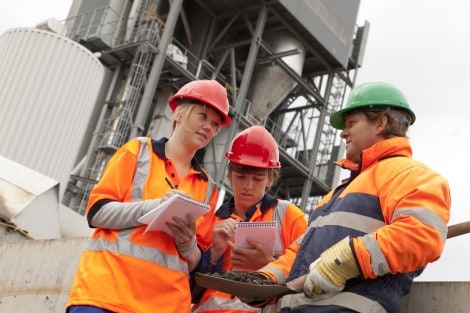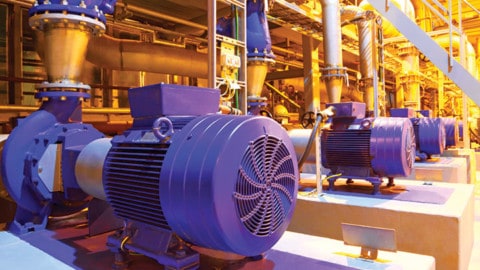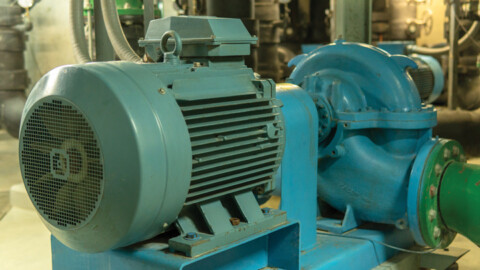By Keith Sanders, PIA Life Member
When Chris Bland asked me to write an article for Pump Industry, I had no problem accepting the task, because I have had more the 55 years involvement in the process from an engineer’s perspective; firstly as a student, then as an employer and finally as a trainer.

Under the post war Labour Government in UK, there was a significant emphasis on education to replace what was effectively a “lost generation” of people, who should have taken up the jobs in manufacturing, commerce and social services. As a result, my involvement in serious education & training began in 1958, when I was encouraged to stay on in the Sixth Form for 2 additional years schooling and prepare myself for a University education in Mechanical Engineering.
What followed was a 5 year Graduate apprenticeship with Hawker Siddeley Group in UK and a career in the manufacturing sector, largely with rotating equipment manufacturers of printing press drives, conveyors, overhead cranes and, finally, pumping equipment.
Today, I am still involved in this field. I run a small consultancy business, which has a clear focus on the transfer of knowledge to young people entering the pump industry or enhancing the appreciation of the technology behind the equipment with operational and service personnel of pump users.
While the Pump Industry may not be a major manufacturing activity in Australia these days, it still has to cater for increasing demand for sophisticated pumping solutions and the market is clearly growing based on PIA market research. The challenge the Industry faces is to provide ongoing expertise to the many thousands of users of pumping equipment in all aspects of our modern society. Supply and servicing such equipment at world competitive levels remains a major strategic issue for Manufacturers, Distributors and Service providers. How can this expertise be transferred to the next generation?
Company training
When I came to Australia in 1981, the Australian Pump Industry was represented by the Australian Pump Manufacturers Association (APMA) and nearly all the major pump manufacturing companies had a representative on the Council. APMA was instrumental in publishing the first edition of the Technical Handbook, to provide a basic training tool with generic information about a wide range of pump types and pumping applications. This was quickly adopted as a “must have” in one’s personal library. However, at that time, most of the companies ran in-house training programs which were designed to develop the next generation of talent to fill key role in the business. These were programs that combine both “on the job” and “off the job” education and training to develop the skill levels necessary to secure the future of the business moving forward.
Most of these companies had professional Human Resources Departments, whose role was to prepared development plans for individuals based on their education level, their aptitudes and the career ambitions. It was not a “one size fits all” approach and managers were encouraged to communicate with staff on a regular basis so that any investment in education and training had a concrete payback for the business. Personal development plans were mutually agreed and provided clear career path opportunities for those prepared to make the effort to improve their knowledge and skill levels.
Southern Cross was famous in the Industry for its training program for young engineers, which consisted of spending a period in the plant in Toowoomba to understand what the company made, how it was made, how it was used by customers and how it needed to be serviced. There were modules covering all the major products that Southern Cross supplied in the Australian market. Sadly this program is no longer available in the form that existed through to the 1990’s when mergers and takeovers changed the previous management style of the business owned by the Griffith family. PIA personalities like Andrew Black, Geoff Sheedy and Bou Spithoven were inducted through this program. The company also supported me personally when I took up a distance learning program to complete an MBA at Deakin University. I will be forever grateful for that support.
Ajax Pumps, as part of the Macpherson’s Group, also ran a Cadet program from the Factory in Tottenham. Some of the senior members of PIA Council and Executive participated in the program. Harry Katunar and Ken Kugler immediately spring to mind.
These are only two examples, but this was typical of the “win-win” approach to education and training accepted by most of the major companies in Australia.
Apprenticeships
One of the significant features of this period of Australian Industry was the strong connection between these major engineering firms and the Institutes of Learning. Whether we are talking about Universities, Institutes of Technology or TAFE colleges, there were educational programs designed to support the needs of Industry for well educated and well trained staff, such that recruitment opportunities were easily filled and career development for individuals was assured. It might be argued that this was modelled on the UK experience of the 1960’s. There were educational and training programs and apprenticeships to cater for every level of worker that needed to be accommodated within the system.
Craft apprentices – these were usually blue collar workers who would undertake trade skills development by working along-side qualified tradesmen. Their trade educational needs were catered for by outside Institutions of Learning by attending day release or evening classes at Technical Colleges for Trade certification.
Technical Apprenticeships – were for white collar workers who could be involved in drafting and design roles, works engineering or installation supervision, sales positions etc. Again, their educational requirements were met by outside Technical Colleges at Ordinary or Higher Certification levels that are required to meet the technical challenges of their intended role in the business.
Graduate Apprenticeships – were for white collar workers who were seen to have management potential and who could occupy future leadership roles in the business. The educational needs of such personnel were met by Universities or Institutes of Technology, offering degrees or diplomas in various disciplines such as Engineering or Sciences.
As a result, Australia developed a reputation for being a reliable supplier of pumping equipment, manufactured and tested in Australia to very high engineering standards. I spent 5 years in S. E. Asia from 1977 to 1981 working for Kelly & Lewis Pumps and, during that time, Australian companies were held in very high regard for the quality and reliability of their pumping equipment. Distributors would fight to acquire an Australian Agency for pumps, since this was a product vital to the development of S E Asian nations as they struggled to provide basic services of housing, water and power for their communities.
The changing scene
Significant market rationalisation has occurred over the past 25 years and the scene in 2012 is significantly different. Most of those traditional Australian pump manufacturers have either been acquired by foreign investors or gone out of business. Imported products have increased significantly. While demand for pumping equipment continues to trend upwards, manufacturing in Australia has become less competitive due partly to the reduction in tariffs and other forms of protection, partly due to economies of scale in overseas factories and partly due to the high Australian dollar.
Not much can be done to arrest these trends in the short term. However, in my view, the most significant threat is the loss of skills within the Pump Industry and the ability of local businesses to offer world class solutions for the complex range of pump applications needed in the Australian market. We need to ask ourselves some serious questions about the future career prospects for young engineers who may wish to consider entering the business and allow them to reach their full potential as engineers or executives.
In this respect, I am conscious of a lack of human resources to meet the current demand for competent staff. As a trainer, I am often asked “Can you recommend anyone for this vacancy?” This demonstrates there is a need for more qualified people in the employment market.
In addition, it is evident that Australia has well developed education resource in Universities, Institutes of Technology and TAFE Institutions.
However, there seems to be an apparent disconnect between Industry, Institutes of Learning and the current crop of students passing through the system. What do we need to do to make a career in pumps “sexy”?
PIA has had a mixed experience in working with educators in the recent past. Some years ago, PIA funded a Pump Test laboratory at Caulfield. Within a couple of years this facility was closed down due to a lack of demand.
More recently PIA worked with TAFE at Moorrabin to develop a comprehensive pump training course. This was partly funded by PIA, in an effort to get something up and running. Again, the program was dropped shortly afterwards due to lack of interest.
Efforts to invite University and TAFE students to PIA seminars at no charge have not been taken up. Clearly, the current crop of students does not see the Pump Industry as an attractive career path.
With a low unemployment level in Australia, it seems that people can pick and choose the career that will provide them with the best work/life balance. Employment opportunities in the Resources sector are skewing the segmentation of jobs in the short term, but most of us realise that Australia will require other sectors of the economy to pick up, once the boom subsides. This will include manufacturing and by extension, the pump industry. The Government seems determined to prop up the motor industry with huge subsidies, yet pumps do not capture the imagination as readily as that glossy Holden in the Executive car park.
Some solutions?
What is needed is a “Master plan” with inputs from all stakeholders, addressing the challenges that lay ahead. The resources are basically there and it just requires a properly coordinated effort to bring them together.
- Australia need pumps;
- Pumps need servicing;
- People provide services;
We need to raise the profile of the Industry to a level which will encourage young engineers to join our ranks. This can be done by developing genuinely attractive career paths for them and publishing the benefits of making such a commitment. Ad hoc training programs to meet immediate short term objectives often do not get the intended longer term outcomes.
- Why not a PIA award for the best performing graduate in Hydraulic Engineering?
- Why not a PIA stand at end of year career Expos for new Graduates?
- Why not integrated work experience for under- graduates to get a taste of the charms of the centrifugal pump?
In addition, we must develop links with senior course designers to ensure that the significance of pumping equipment in modern society is reflected in the course content and that the material is practical and relevant to present applications. Who needs Archimedes?
Finally, we need to get Government to find some new funding initiatives for both product innovation (R&D) and education & training. All too often, funding is linked to very prescriptive program designs and does not appear to encourage specialist training in particular areas of expertise. Bottom line is that State & Federal Governments are just too hard to deal with on many occasions.
Meanwhile, the “old-timers” of the Industry lament that there are few opportunities to pass on the knowledge that once made pumps an important part of the Australian manufacturing scene. In my opinion, this provides a real opportunity for PIA and the larger multi-national pump suppliers to draw up a coordinated program for the future. We want our industry to thrive, not just survive and this means we have to take the lead role in generating solutions.

















